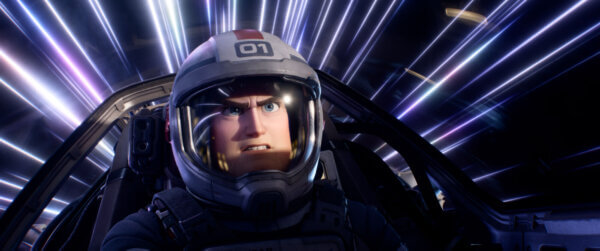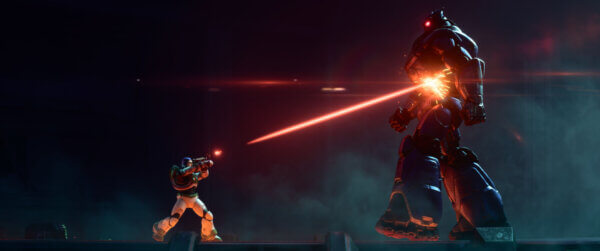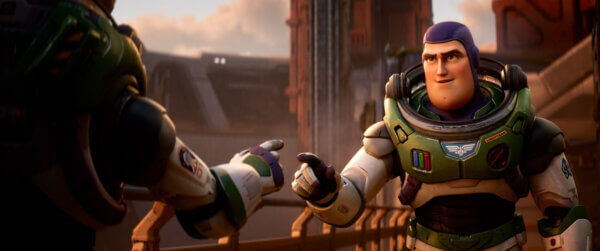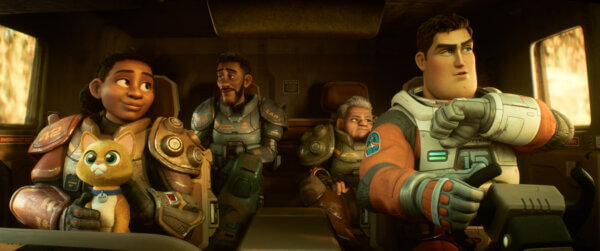Can Lightyear Avoid Overfamiliarity?
Nostalgia has been a key ingredient for Pixar since its inception. So many movies within their canon look to not only relate to children but to place adult viewers back into their childhood. Whether it’s their first film, a testament to the bonds we built between us and our toys, or their latest, an early 2000s throwback. Pixar will return to the nostalgic well once more with Lightyear, the sci-fi action-adventure film which caused Toy Story protagonist Andy to fall in love with Buzz Lightyear.
The cynic in any audience member will group this in with the wider Hollywood (and Disney) trend of attempting to breathe new life into old franchises for the cheap nostalgia-bait. Suspicion around Lightyear heightens once you learn of its riffing on 80s sci-fi aesthetics, yet another nostalgic premise.
However, despite Lightyear fitting a corporate bill, behind that box office criteria are filmmakers with genuine passion for heartfelt and unique storytelling. Creating something that meets audience expectation and warns off critic cynicism leaves the filmmakers on a balance beam of their own making. Giving Lightyear its own voice is something that the team behind the film have obsessed over, determined to innovate on these established styles, determined to not fall into a pit of overfamiliarity.
The Visual Language of Buzz
Separating the character of Buzz Lightyear from Toy Story is close to impossible, his iconography being the most ubiquitous to come from that franchise. Therefore, the task of removing overfamiliarity comes from the conversion between Buzz as a toy and Buzz as a believable human within the universe of the film. Aspects such as ensuring his classic suit has practical use within the film, having him feel natural inside other outfits and inventing Buzz Lightyear’s hair were left to Fran Kalal, Lightyear’s Tailoring and Simulation Supervisor, who spoke to Skwigly about that process.
“The Buzz Lightyear toy has seams on it that show that this is a toy that’s been manufactured, so it’s really important that the hard surface detail on the human Buzz Lightyear looks like it was manufactured for human scale… the shading goes on top of that and shows the wear. So there’s human scale scratches and human scale wear.”
This differentiation between toy and human is extended to the movie’s policy of removing Buzz from the familiar Toy Story cast (with the exception of Zurg). The original characters which populate Lightyear give depth to the world and establish it as unique.
Buzz develops relationships of the type we have never seen in a Toy Story movie, a necessary storytelling decision. Director Angus MacLane was clear about his intentions to not constantly remind the audience of the Toy Story canon, but in his conversation with Skwigly he maintained that there are certain expectations to meet.
“We had a list of things that we wanted to have in the film. Most notably, Buzz and Zurg had to face off, we wanted to see what the elevator fight from Toy Story 2 looked like in the film and make sure we had the requisite upgrade of that scene, then there were some lines we had to pay off. I did feel that there were definite guardrails of what the audience would expect from the film.”
There is only so much you can change about a character, until they are someone else entirely. The Lightyear team have put a lot of brainpower into separating Buzz from the familiarity of Toy Story, but have placed him in an environment intentionally reminiscent of a golden age on big-screen sci-fi.
A Planet Far, Far Away
The aesthetic developed by sci-fi movies of the 70s and 80s never truly went away, with its pioneers, Star Wars and Star Trek, yet to leave the general consciousness. In fact, modern Star Wars iterations such as The Mandalorian look to replicate that aesthetic following lukewarm reactions to CG-heavy entries. Lightyear, set on being a space-faring movie which could have realistically been released in the 80s of the Toy Story universe makes for another almost impenetrable wall of overfamiliarity for the filmmakers to parse.
Any space-faring film will have to grapple with the depiction of the vast vacuum. 2001’s desolate, horror-inspired space is a far cry from the casual transport route it appears as in Star Wars. Lightyear’s representation of space sits slightly outside of those, opting to see the wonder and opportunity in space, something imbued to it by Director of Photography Jeremy Lasky.
“We went through different versions of what space would look like and since Buzz is a Space Ranger, it’s about opportunity, it’s about the excitement of the unknown and not this fear about what’s out there. The main goal was, ‘how do we make it feel exciting? and how do we make it feel like this ship is going fast.’”
A hallmark of 70s sci-fi that Lightyear looks to retain is the worn, lived in nature to the technology in the film. There are glossy touch screens, but a heavy emphasis on metallic AI which looks like it’s lived a life of its own. While this familiarity will undoubtedly have the audience reflect on their Star Wars affection, it doubles as a way to establish a universe that feels real and grounded. Additionally, the design of the technology was given much deliberation by Sets Art Director Greg Peltz who wanted to give the tech of Lightyear a blocky, chunky feel.
“We have this base template of Buzz Lightyear’s armour, and at the same time we have this 80s futurism vibe that we are inspired by. So how can those two things inform each other? A big part of it for me is when you look at Buzz Lightyear’s armour, the things that stick out are the buttons, big, bright coloured buttons. Something about that stuff specifically screams out to me as a designer. Everything we make needs to have a cool visual focal point whether it’s an array of buttons here or a brightly coloured thing here that kind of brings things into that toy space. So it’s almost like taking this retro-futurism vibe and toyifying it.”
Though any space-set adventure film will be compared to Star Wars until the end of time, the intention of the filmmakers to pay homage and innovate on that style is admirable. The sheer fact of it being an animated film means the story and visuals can be taken to places that live action sci-fi staples have never been before, giving Lightyear its own language.
Time’s Arrow
For the first time in a while, mainstream animation seems to be moving forward. Innovation is everywhere with studios like Sony, Cartoon Saloon and Dreamworks producing work that feels distinct from each other but also from their own past work. Even within Disney, the last few months have seen the releases of Turning Red and Encanto, two movies that show much needed sparks of imagination from their respective studios.
With the industry looking to create something new, how long can Pixar keep looking back? The 2010s produced a barrage of sequels which cost them their status as industry pioneers and the days where each Pixar film felt like a new experience started to feel distant.
Lightyear is not a half-hearted return to a world we know, but it isn’t a prophecy of where the future of animation lies either. My hope for Lightyear is that it is a true crown on the era of Pixar dominance, a victory lap for this style of animation and for their most iconic creation to date. While movies like Turning Red excite audiences for the future of Pixar, the idea of Lightyear being the full strength incarnation of these movies that provided the formative moviegoing experiences for so many of us is enthralling.
Lightyear releases June 17, 2022.





